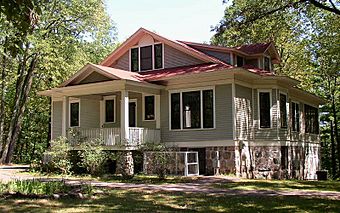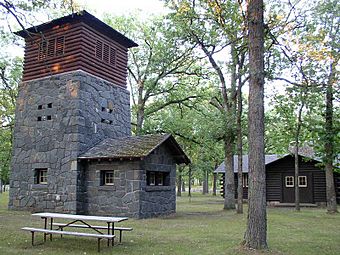Charles A. Lindbergh State Park facts for kids
|
Charles A. Lindbergh House and Park
|
|

The boyhood home of aviator Charles Lindbergh stands in the park donated in memory of his father.
|
|
| Location | Morrison County, Minnesota, United States |
|---|---|
| Nearest city | Little Falls, Minnesota |
| Built | 1906 |
| Architect | Carl Bolander |
| NRHP reference No. | 70000303 |
Quick facts for kids Significant dates |
|
| Added to NRHP | November 20, 1970 |
| Designated NHL | December 8, 1976 |
|
Charles A. Lindbergh State Park WPA/Rustic Style Historic Resources
|
|

Water tower and picnic shelter, constructed 1938
|
|
| Location | Pike Creek Township |
|---|---|
| Area | 9 acres (3.6 ha) |
| Built | 1938–39 |
| Architect | National Park Service, State of Minnesota, Works Progress Administration |
| Architectural style | NPS Rustic |
| MPS | Minnesota State Park CCC/WPA/Rustic Style MPS |
| NRHP reference No. | 89001655 |
| Added to NRHP | 1989-10-25 |
Charles A. Lindbergh State Park is a cool place to visit in Minnesota. It's a big park, about 569 acres (2.3 square kilometers), located near Little Falls. This park used to be the farm of a famous family: Charles August Lindbergh, who was a Congressman, and his son, Charles Lindbergh, who became a world-famous pilot.
Inside the park, you can see their old 1906 house and other farm buildings, which have been carefully restored. The house is so important that it's called a National Historic Landmark. The Minnesota Historical Society takes care of the house and a museum next to it, called the Charles Lindbergh House and Museum.
The park also has special buildings and structures built in the 1930s by a group called the Works Progress Administration (WPA). These include a picnic shelter and a water tower. They were built in a natural, "Rustic Style" using local stone and logs. These WPA buildings are also very important and are listed on the National Register of Historic Places. Even though the park is next to the Mississippi River, the Lindbergh family wanted it to be a quiet place. So, you won't find big swimming or camping areas here.
Contents
The Lindbergh Family Farm: A Look Back
Charles August Lindbergh, often called C.A., was a lawyer and businessman in Little Falls. In 1901, he married Evangeline Lodge Land, a smart teacher from Detroit. They moved to a farm C.A. had bought earlier. They built a large, three-story house overlooking the Mississippi River.
Young Charles Lindbergh's Childhood Home
Their son, Charles Augustus Lindbergh, was born in 1902. He was their only child. The farm had many animals, like cows, goats, pigs, sheep, and chickens. There were also cats and dogs.
In 1905, a fire sadly destroyed their big house. The family was safe, and they saved many of their belongings. They built a new, smaller house on the old foundation. This new house had a unique design with a short hallway and many doors. The upstairs and basement were never fully finished.
Charles Lindbergh's Early Life and Dreams
C.A. Lindbergh became a Congressman in 1907. For the next ten years, young Charles spent most of his time in Detroit and Washington, D.C. But he loved the two or three months he spent each year at the farm in Little Falls. He later said that his time on the farm and playing by the Mississippi River made him strong and independent.
The unfinished upstairs became Charles's special play area. One day in 1911, he heard a very loud engine. He climbed onto the roof and saw his very first airplane! This moment might have sparked his interest in flying.
In 1917, Charles and his mother moved back to the house full-time. Charles often slept on a screened-in porch, even in cold weather. He helped manage the farm and was interested in new farm machines.
From Farm Boy to Famous Aviator
Charles left for college in 1920. He only came back to the farm once, in 1923. He arrived in his own Curtiss JN-4 plane, landing it in a field on the property! After this, the farm was mostly left alone.
In 1927, Charles Lindbergh became incredibly famous for flying solo across the Atlantic Ocean. After he became famous, many people wanted souvenirs from his childhood home. They often broke into the empty house, causing a lot of damage.
Creating Charles A. Lindbergh State Park
To protect the house and land, the Lindbergh family gave their 110-acre (0.45 square kilometer) farm to the state of Minnesota in 1931. They wanted it to be a park to remember C.A. Lindbergh. The family worked with the Minnesota Historical Society to fix up the house and donated many of their original furniture pieces.
The Works Progress Administration (WPA) helped develop the park for people to enjoy. In 1969, the house and its grounds were given to the Minnesota Historical Society. In 1973, Charles Lindbergh gave his last public speech from the porch of his boyhood home at the opening of a new visitor center. He passed away the next year.
The visitor center first focused on the history of three generations of Lindberghs. But after a renovation in 2002, it now has more exhibits about Charles Lindbergh, the aviator, and his amazing flights.
Historic WPA Buildings in the Park
In 1989, the WPA buildings in the park were recognized as a special "historic district" on the National Register of Historic Places. This area is about 9 acres (3.6 hectares). It includes six important features: two buildings (a picnic shelter and a restroom), two structures (the water tower and a wall along Pike Creek), and two drinking fountains. All of these were built between 1938 and 1939.
These WPA projects are important because they show how federal programs helped people find work during the New Deal era. They also show the special "National Park Service Rustic" design style, which uses natural materials to blend with the environment. A similar picnic shelter design can be seen in Lake Bemidji State Park.
Exploring the Park Grounds
The land in the park was shaped by glaciers thousands of years ago. You can even see large Slate rocks in Pike Creek that were carried here by those glaciers from far away. The plants and trees in the park are much like they were before people settled here, with pine forests, oak trees, and open grassy areas. The Mississippi River's water level is now higher than when Charles Lindbergh used to swim in it.
The park has a campground with 38 spots for tents or RVs, and 15 of those have electricity. There's also a group campsite for up to 30 people, a walk-in campsite, and a special canoe-in site right along the Mississippi River.
See also



